Hunting white-tailed deer is not only challenging, but it is exciting as well. For centuries, hunters have gone whitetail hunting for food, but more recently deer hunting has also involved sport hunting. In addition to recreational hunting, hunters and landowners have begun to implement intensive whitetail deer management programs to improve the health and quality of the deer and habitat found on their properties. When it comes to whitetail deer hunting, all hunters are looking for techniques that will make them more successful. Whether it be bagging a deer or bagging a mature buck, whitetail deer hunting is a challenge. Continue reading Whitetail Hunting
Tag: Whitetail Hunting
Big Kaufman County Whitetail Buck Harvested
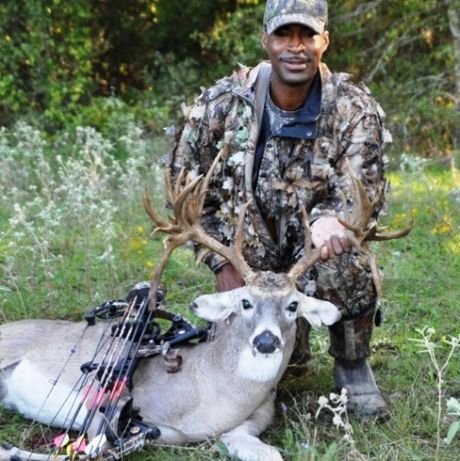
Texas Parks and Wildlife Department game warden Eric Minter is living large. That’s because on October 21 he found himself as the lucky hunter staring down the buck of a lifetime from a Gorilla treestand hung high in a creek bottom filled with white oaks raining acorns. When all was said and done, it was Minter putting his own tag on a whopper 27-point non-typical Kaufman County buck. There is no official green score number on the multi-tined monster yet, one look at the photos from the buck would lead one to believe that this deer will score well above the 200-inch mark on the non-typical side of the Boone and Crockett scoring sheet.
“I’ve been kind of leery of telling everybody just yet because I don’t know what he scores and I don’t want to guess and it be a lot lower or higher than I expected,” Minter said. “But this is unbelievable.” Some observers who have looked at the whitetail think it’s possible that the Minter buck could potentially challenge the existing Pope & Young Club state record non-typical in Texas, a 225 7/8 inch buck taken by bowhunter Jeffery L. Duncan on the Hagerman National Wildlife Refuge back in 2001. Not bad for Minter’s first bow buck. Continue reading Big Kaufman County Whitetail Buck Harvested
Deer Management on Small Acreage
Question: A couple fellow deer hunters and I were talking about managing whitetail deer on low fence land. The topics of buck to doe ratio, mature bucks, and letting deer go and grow all came up. The question nobody could give a good solid answer to was “if you start taking doe to get a better ratio, will the bucks leave the ranch to go where there are more does?” Most of these hunters hunt properties ranging from from 200 to 900 acre low fence properties. What do you think, because I was of the opinion that property size would play a big role? Less deer means more food for the ones there already, but I can also see where the bucks might just go to another ranch that has an abundance of doe?
Answer: The positives of a good deer management program definitely out weigh all of the concerns you mentioned regarding your local deer population. A better buck to doe ratio will give you a more defined rut, but you also have to realize that if you reduce the number of deer on your property, then neighboring deer will also move into your ranch. Particulary when times are tough. Antlers will get better with a lower deer density. Of course, with a better buck to doe ratio you will see more of your bucks, and it just makes the hunt more fun in my opinion.
If you have small acreage then concentrate on improving your deer habitat and making certain parts of your ranch sancuary areas that you simply stay out of. Thats the way to hold mature bucks on your property. Most people hunt every square inch of small properties and that’s where they go wrong. Bucks can roam as much as 3 to 5 miles in one day during the rut, so you will not be able to hold all your bucks, but you will probably gain some, too. I have regularly harvested does on our ranch and activity during the rut is awsome. We also see some of the same bucks year after year.
I know some guys that have been managing a 640 acre low fence place for the past 12 years with some outstanding results. And yes, the ranches around us are deer hunted, too.
Improving Buck to Doe Ratio
Question: I recently purchased a 700 acre ranch located in North Texas and am interested in deer and habitat management. I am confident that the buck to doe ratio is skewed and that there are many more does than bucks. Over the past hunting season we made quite a few deer observations from hunting blinds, and we saw about 5 does for every buck. And most bucks were young. We don’t really have an idea of what the total deer density is, but we know that we want to remove about 50% of the does so that we can get the ratio down to 2 does for every buck. What do you think?
Answer: I must point out that removing whitetail deer from your property, regardless of sex, creates more food for the remaining deer population. Everyone understands this simple concept, but don’t forget that deer will adjust their home ranges from neighboring lands and likely spend more time on your property because of decreased competition for forage. If the deer habitat on your property is at least as good as your neighbors habitat, then deer in the area will “immigrate” onto your ranch (meaning it will become a more important component of their home range) and re-balance.
If your deer habitat is much better than the surrounding area, then whitetail deer will continue to move onto your property (use your ranch much more) at much higher rates and you will see rapid changes with regard to buck to doe ratio. Bucks always position themselves for optimal food. This is why whitetail bucks are always anchored next to protein feeders, high quality food plots, and the best natural forage. So removing half of the does will improve your ratio, but remember than additional does and bucks will move in from surrounding ranches. It will take several hunting seasons, but it can be done.
Whitetail Hunting: Not Seeing Any Bucks?
Question: This my first year on a new deer hunting lease. The habitat is great and I am sure it will be good hunting. Anyway, last week I put out two game cameras over two different deer feeders. After checking out the pics, I am only seeing does; large groups of does and no bucks at all. All of the other hunters on the lease who have cameras out are getting pictures of some very nice whitetail bucks. The land we hunt is basically the same with no notable difference and we are all throwing corn, so why am I not seeing any bucks at my feeders?
Answer: Stay calm. If you have does hanging around then you will have bucks. A lot of hunters think deer feeders are a cure all for deer hunting. Don’t think that you will shoot a good buck at a feeder, but think that you will attract does to your feeder and then the does will attract the good bucks. If you have the does, the bucks will surely come your way come the rut.
In the past, I’ve tried all kinds of deer scents, including doe in estrus and drag rags. The absolute best deer attractant of all of them is a whitetail doe in heat. So, if you say you have lots of does on the cameras, then relax and wait. You are in a good place. Now, it’s only a matter of time before they go into rut. Get in the stand around the rut and you will see all kinds of action. The bucks will be looking for does, and guess what? You’ve got them!
Deer Hunting in Kansas – How Does It Work?
Question: My father and I would like to go to Kansas whitetail deer hunting this year and we are wondering if you could give me the steps to take to get something planned or done for the upcoming hunting season? I have heard that alot of the farmers up there will let you hunt for next to nothing, but is this true? Any advise you can give me would be greatly appreciated.
Answer: As non-residents you will have to put your name into the draw for Kansas deer hunts. If you have a place to hunt in Kansas that information will be required for your draw permit. Because that information is needed, you will need to find a farmer that will allow you to hunt before you apply for the permit.
Draw permits are over $300 this year plus about $75 for the non-resident hunting license. A large portion of the land in Kansas is leased by outfitters from the farmers. However, it is not impossible to find farmers that will allow you to deer hunt. I have known hunters that have met some of the locals that have allowed them to hunt deer.In areas where there are a lot of farmers and very few hunters, the deer will eat the crops and are a nuisance.
Also, there is a lot of public ground to hunt. Look at North Central to Northeast Kansas. Some walk in areas have really good looking country. Another tip would be to contact every chamber of commerce and every vistor site you can.
Best Feeder Times for Whitetail Hunting
Question: I hunt in North Central Texas, what are the best feeder times to set for morning and and evening during the general (gun) deer hunting season? Thanks for your help in adance.
Answer: For most of Texas, a good rule of thumb would be to have your spin feeder run around 6:45 a.m. and about 3:30 p.m. Some hunters prefer a bit later in the morning and in the evening, but the times mentioned above have worked well for me in the past.
When a spin-feeder goes off, some deer wait for the noise of a feeder and then come right in. These are typically the younger and smaller deer, which many hunters are not looking to shoot, at least not right away. These early deer want to get there and grab a bit before the dominant, deer, bigger bucks kick them out. This is especially true later into the evening.
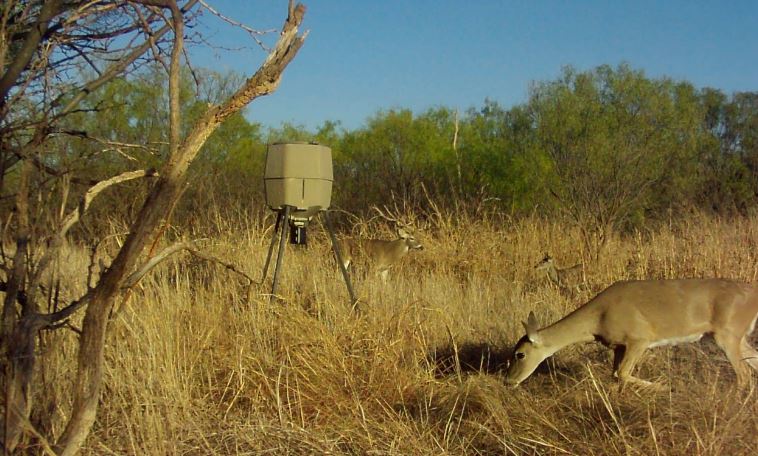
Automatic Deer Feeder Times by Location
In my opinion, selecting the ideal or best time for a deer feeder to run really does vary with feeder location. If a feeder is located in a wide-open field, then it needs to run very early in the morning and later in the afternoon. Deer are more apt to feed in open areas when the sun is low in the sky.
On the other hand, spin-feeders located within an adjacent woodlands are more likely to be used for longer periods of time during both the morning hunt as well as evening hunts. Deer prefer low-light situations, so I actually prefer to position the deer feeders I use in such a way to take advantage of shadows cast by trees.
For example, let’s say I have a woodline to the west of my stand. If I place Feeder A 5 yards off a woodline and Feeder B 50 yards off a woodline, which feeder will have deer first in the afternoon? Feeder A. First, it’s close to cover and, secondly, it’s going to be in the shade.
Shade is important because it helps to conceal the deer. Deer and other wild animals do not want to stick out like a sore thumb. Shade is also important, at least here in Texas, because sometimes it can still be quite warm in the afternoons during deer season. Feeding in the shade allows deer to remain cooler.
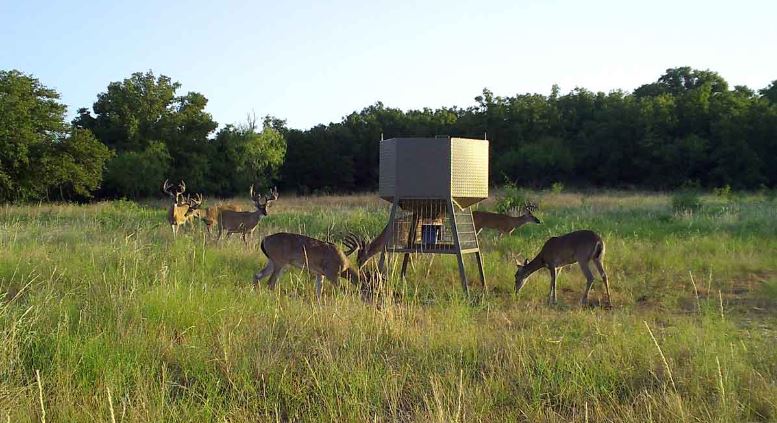
Best Deer Feeder Times
In the example above, the best time for Feeder A to run would be just before the shade covers the feeder, probably around 4:30 p.m. or so. The best time for automatic deer Feeder B to run would be just before sunset, so probably 5:00-5:15 p.m. or thereabouts.
Hunters are using feeders to attract deer, but ideally they want to attract mature deer, specifically mature bucks. A feeder needs to run at the ideal time in the afternoon as to attract older bucks early enough in the evening, with enough daylight to see the antlers on their heads clearly.
If you can get the does to come in early in the afternoon then it’s only a matter of time before the older bucks come following closely behind, particularly during the rut. That is, if there are any mature bucks in the area.
Texas Deer Feeder Times?
Although most hunters will consider an evening time later than 3:30 p.m., you’ll be surprised at what you will see during the early afternoon, especially with proper feeder placement. Early feeder times are great in the morning, except that on a cloudy morning you may have the deer (especially if you have a high deer density) consuming most of the feed before you can see them very well.
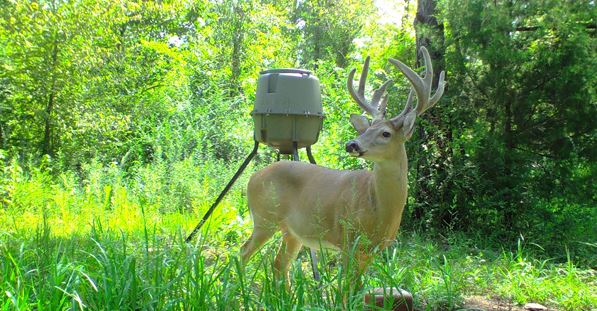
From my experience using deer feeders, the larger bucks tend to be visit very early in the morning early in the season, so the earlier your feeder can go off, the more likely you are to have larger bucks come in. Of course, they may finish eating before you can see well or can legally shoot.
To bring a buck a buck in early and hold him there, set your automatic feeder to feed for about twice as long in the morning than it does in the evening. Again, I like feeder times about 6:45 a.m. for a morning feed. Just make sure to get there well before the feeder runs, or you’ll end up blowing deer out of the area.
For the evening hunt, set the feeder to go off based on shade conditions at your feeder. Feeder times anywhere between 3:30 p.m. and 5:15 p.m. make sense. Bucks, especially mature bucks, can show up at any time, but are more prominent around feed sites during the last 45 minutes of daylight.
Do Turkey Decoys Calm Whitetail?
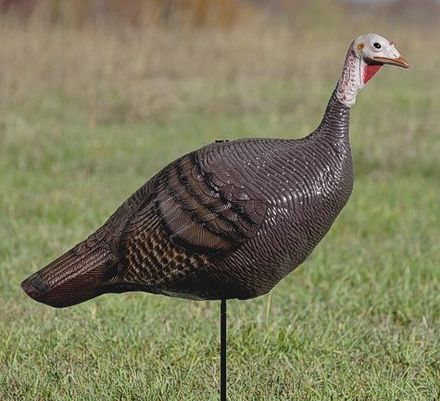
Question: I have tried different types of deer decoys over the years. From my experience, most of the whitetail deer I have observed seem to lockup once they see the deer decoy. Deer seem to know something is wrong. However, while turkey hunting I have had deer come in to my turkey decoys several times. Although a little skittish, deer seem much more comfortable and inquisitive about the turkey decoys. They will most often almost touch them. I think I am going to give them a try next time I head out whitetail hunting. Has anyone tried them for deer?
Answer: That’s a new one, but you really never know! Hunters commonly use deer decoys when deer hunting to lure deer in for a closer look. Bowhunters commonly use decoys to get aggressive bucks to come in and do battle. As such, many bowhunters use buck decoys, but some will also use doe decoys with added scent to make mature whitetail close the distance.
In the waterfowl world, confidence decoys have been used for years. If we take a note from them, then turkey decoys may have the same effect on whitetail deer. The turkey decoy may act as a confidence booster for whitetail. As most deer and turkey hunters know, turkey are about 10 times more spooky than your average whitetail.
I think you may be on to something here. Give your turkey decoy a shot because I surely don’t think it will hurt. Good luck with your experiment and whitetail hunting!